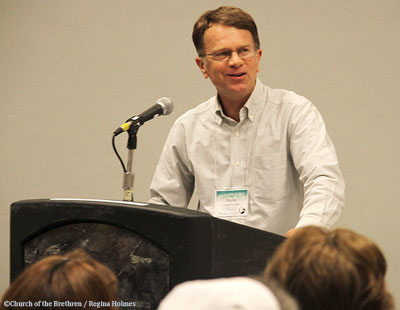 |
| Photo by Regina Holmes |
| Brethren historian Steve Longenecker leads insight session on the Battle of Gettysburg and the Dunkers during Annual Conference 2013. The 150th anniversary of the Battle of Gettysburg occurred in early July. |
Many people have heard of the terrible fighting around the Peach Orchard during the second day of the Civil War Battle of Gettysburg in 1863. What most Brethren probably don’t know is that the peach orchard belonged to a Brethren family, Joseph and Mary Sherfy.
Like other Brethren, and indeed most people living around Gettysburg, their financial losses from the battle were high–fruit, wheat, stockpiles of wood, and fencing. A bullet passed through the folds of Mary’s dress (she kept it for a souvenir). The hog stable and the outbuildings were destroyed, and 15 charred bodies were found in the wreckage after their barn burned to the ground.
Two years later there was an advertisement in the Baltimore Sun offering “Battlefield Peaches” for sale ($4.50 for a dozen quarts, $12.00 for a dozen gallons), harvested from that famous Peach Orchard. For Joseph and Mary Sherfy, and indeed most of the Brethren from the nearby March Creek congregation, life went on.
Steve Longenecker, professor of history at Bridgewater (Va.) College, spoke to a packed room in an Annual Conference insight session, “The Battle of Gettysburg and the Dunkers,” sponsored by the Brethren Historical Library and Archives. Focusing on the Marsh Creek congregation’s records, he noted that the image of a strict, inflexible, unyielding body of Brethren usually pictured from that era is inaccurate. There are records of excommunication to be sure, but the picture that emerges from close study is one of “visits, warnings, and forgiveness. They were a living Brethren fellowship with high points and low points of human behavior, but mostly it worked pretty good.”
Longenecker described the struggles the Marsh Creek congregation, and indeed all Brethren, had with sharing the Holy Kiss with African American members. The denomination insisted it be shared, and a sizable percentage of Marsh Creek agreed, which is impressive considering the congregation was only seven miles from slave territory.
If 18th and 19th century Brethren were inflexible on anything, it was slavery. They were adamantly opposed to slavery. As Longenecker noted, from the perspective of the 21st century, “refusing to allow slaveholders as members feels good.”
Longenecker listed what is considered a conservative amount of fatalities, 750,000 for the Civil War years. “One in three white men of military age from North Carolina died,” he said, giving a sample statistic. “Such insanity and hell makes pacifism and the Brethren look pretty good,” he added.
Longenecker’s stories relied on vivid detail, such as descriptions by survivors of giant blue-green flies that descended in thick swarms on the battlefield after the fighting ceased, and the “overwhelming stench” that assaulted visitors miles from Gettysburg as they arrived to see what had occurred. His research was often able to catalogue exactly the number of acres of wheat lost or fence posts stolen by both Confederate and Union armies.
Perhaps one of the most important things Longenecker has discovered is that in its first congregational meeting after the Battle of Gettysburg, just five weeks after the most terrible battle to take place on American soil, the Marsh Creek Brethren put their fall Love Feast first on the agenda. They affirmed that–despite the losses all had suffered–there was no question that Love Feast would take place. Faithful life in Christ would go on.
— Frank Ramirez is pastor of Everett (Pa.) Church of the Brethren and a member of the Annual Conference News Team.